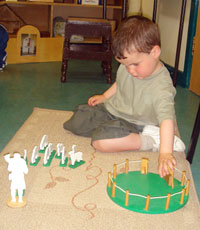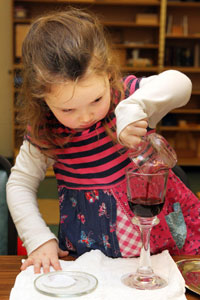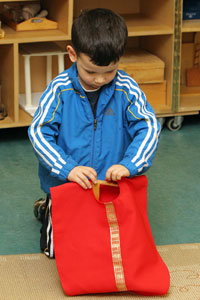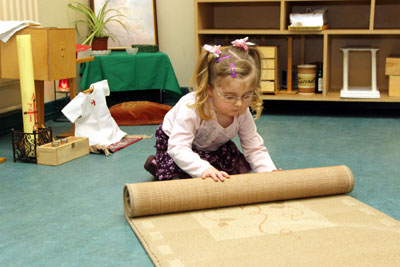What is an Atrium?
 An
Atrium is a room of special beauty with miniature replicas of the
materials the children see in the Church, pictures, coloured vestments,
all designed and in proportion to the children’s size and placed
on low shelving. It is a place where children familiarise themselves
with concepts and materials relative to religion. This Atrium fosters
the religious life of children and the materials help them to concentrate
thus nurturing the capacity for contemplation. The materials consist
of objects which the children can touch, hold, manipulate and work
with according to their needs. Small models of everything found
in the Church are in the Atrium.
An
Atrium is a room of special beauty with miniature replicas of the
materials the children see in the Church, pictures, coloured vestments,
all designed and in proportion to the children’s size and placed
on low shelving. It is a place where children familiarise themselves
with concepts and materials relative to religion. This Atrium fosters
the religious life of children and the materials help them to concentrate
thus nurturing the capacity for contemplation. The materials consist
of objects which the children can touch, hold, manipulate and work
with according to their needs. Small models of everything found
in the Church are in the Atrium.
The Good Shepherd Parable is one of the earlier presentations in
the Atrium. This Parable is presented with reference to the  Biblical
text. The material consists of a 2D wooden sheepfold, ten wooden
sheep and a Good Shepherd model. The material is firstly presented
as a story, then the Biblical text is read and the sheep are moved
accordingly. The purpose of using storytelling primarily to introduce
a topic is to engage the child in the sense of wonder. If the catechist
demonstrates a sense of wonder as the story is being related, the
children will respond accordingly. The goal of this approach is
not to transfer answers or facts but to teach the art of using the
language in a meaningful way and to find direction in life. A presentation
is followed by a reflection period. Dr Cavalletti feels that to
explain the parable would be limiting its meaning. Instead, through
the use of carefully chosen meditative questions, the meaning of
the parable is explored with the children, leading to a better understanding.
Thereafter, an appropriate song is sung, followed by Art work. The
children are free to choose materials which appeal to them and to
work with them on a mat or a table. The Catechist makes herself
available to read the Bible text to a non-reading child during this
working period.
Biblical
text. The material consists of a 2D wooden sheepfold, ten wooden
sheep and a Good Shepherd model. The material is firstly presented
as a story, then the Biblical text is read and the sheep are moved
accordingly. The purpose of using storytelling primarily to introduce
a topic is to engage the child in the sense of wonder. If the catechist
demonstrates a sense of wonder as the story is being related, the
children will respond accordingly. The goal of this approach is
not to transfer answers or facts but to teach the art of using the
language in a meaningful way and to find direction in life. A presentation
is followed by a reflection period. Dr Cavalletti feels that to
explain the parable would be limiting its meaning. Instead, through
the use of carefully chosen meditative questions, the meaning of
the parable is explored with the children, leading to a better understanding.
Thereafter, an appropriate song is sung, followed by Art work. The
children are free to choose materials which appeal to them and to
work with them on a mat or a table. The Catechist makes herself
available to read the Bible text to a non-reading child during this
working period.
 As
the children develop within this religious environment the Biblical
and Liturgical themes are extended further to suit the older children.
It took years of research and years of material-making before a
concise programme was put in place. The responses to the material
had to be verified in different environments, different geographical
and cultural settings to ensure that this was not happening by chance
in one place and not in another. Today a programme exists and Atria
are prepared accordingly for children of 3-6 years; 6-9 years; 9-12
years.
As
the children develop within this religious environment the Biblical
and Liturgical themes are extended further to suit the older children.
It took years of research and years of material-making before a
concise programme was put in place. The responses to the material
had to be verified in different environments, different geographical
and cultural settings to ensure that this was not happening by chance
in one place and not in another. Today a programme exists and Atria
are prepared accordingly for children of 3-6 years; 6-9 years; 9-12
years.
Areas in the Atrium consist of ; a Baptismal Area, where the Baptismal Font, with water has a prominent place; candles and oils that communicate the meaning of Baptism; a Geography area displaying the towns in the life of Jesus, to help children to connect Jesus to real places; a History area displaying the materials of the Infancy Narratives or the Paschal Mysteries; a Eucharistic area showing the materials of the Mass; a Prayer corner where children prepare a small table covered with a cloth corresponding to the colour of the Liturgical Season on which is placed a statue of the Good Shepherd or Our Lady and where the children go to pray. In the corner a small kneeler or cushion is provided to add comfort.
 Once
a week, the children meet in the Atrium for a presentation after
which they have the opportunity to carry out freely chosen activities
where they develop their religious experience together with the
catechists; a place for celebrating the Word of God, for listening,
for praying, for reflecting, for meditating and for work. The experience
of catechists is that children have a strong desire to keep on working
even when the parents come to collect them.
Once
a week, the children meet in the Atrium for a presentation after
which they have the opportunity to carry out freely chosen activities
where they develop their religious experience together with the
catechists; a place for celebrating the Word of God, for listening,
for praying, for reflecting, for meditating and for work. The experience
of catechists is that children have a strong desire to keep on working
even when the parents come to collect them.
Click on these images to view some sample work from the children - Press Esc to exit picture viewer
Aims of the Catechesis of the Good Shepherd
· to establish a loving relationship between God and the child.
· to educate children in Christian Doctrine in a systematic way,
safeguarding the integrity of the message and avoiding any distorted
presentations.
· to put the child in touch with the sources through which God reveals
and communicates Himself in living form; namely, the Bible and Liturgy.
· to help the child to know Jesus as the Son of God.